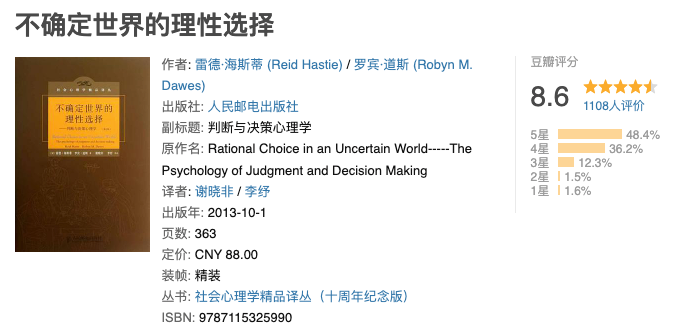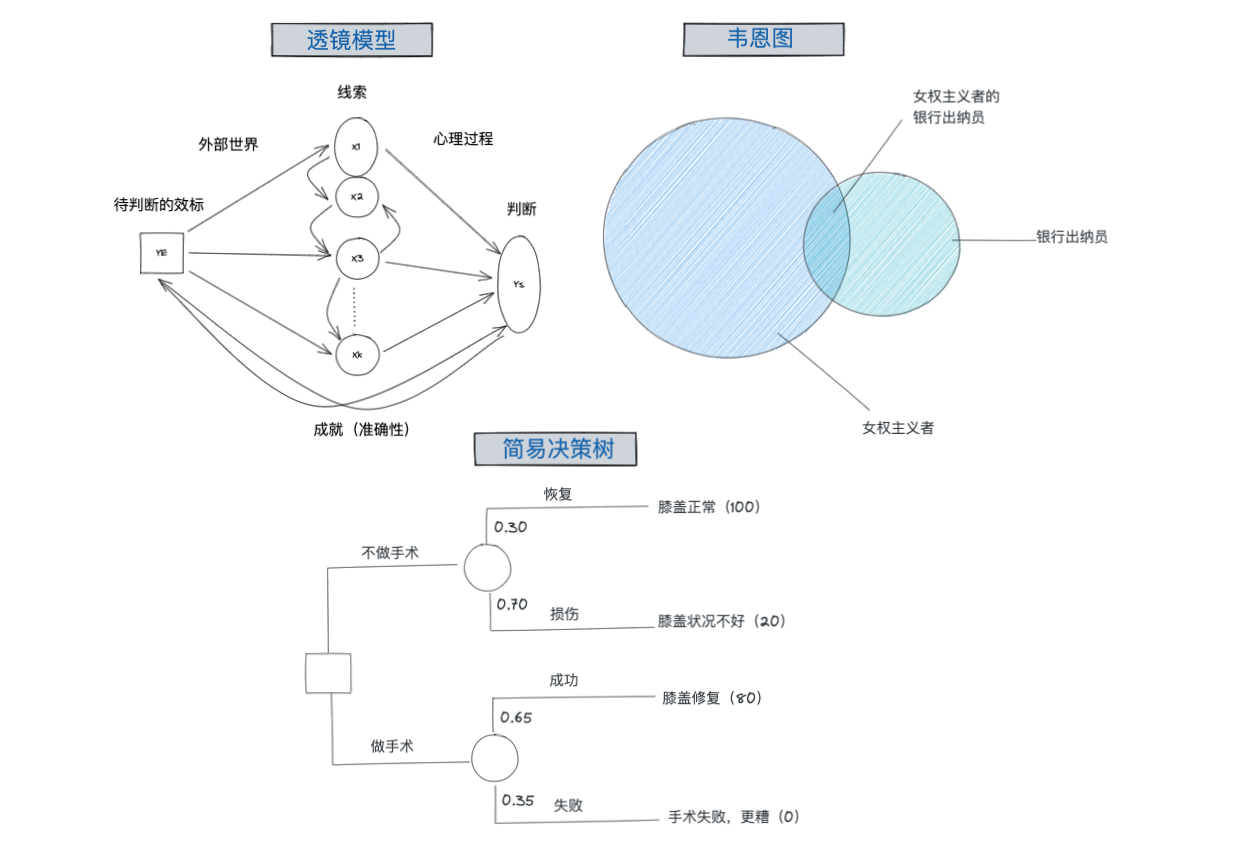Original link: https://aaronnick.github.io/posts/rational-choice-in-an-uncertain-world/
Foreword: This article is a reading and sharing document at the company’s weekly meeting, with slight changes.
Book Introduction

This is a theoretical and academic book with many experiments and papers. The advantage is that some theoretical logic can be clearly explained and there are experimental conclusions . The disadvantage is that it is relatively boring , and some chapters are obscure and difficult to understand.
author
Both authors are researchers in cognitive psychology, decision research.
Reid Hastie, a graduate of UC San Diego and Yale University, began his academic work at Harvard University and actively pursued off-campus research opportunities on medical and legal decision-making in hospitals and courtrooms. His research interests lie in the application of methods and theories of cognitive psychology to judgmental decision-making . He has devoted his life to research in real-world situations, including medical decision-making, legal decision-making, weather forecasting, consumer and business financial decision-making.
Robyn M. Dawes received a BA in Philosophy from Harvard University in 1958 and then entered the Department of Clinical Psychology at the University of Michigan. Two years later, he entered the Department of Mathematical Psychology (PhD in 1963) with an interest in behavioral decision-making, social interaction, and attitude measurement, and completed his graduate education in mathematics. Transferred to Carnegie Mellon University in the fall of 1985 as a professor of psychology in the Department of Social and Decision Sciences , where he is now a professor at Charles J. Queenan, Jr. University. Dawes has published more than 150 papers and 6 books.
Why read?
- Interested in social science and psychology books
- How to make decisions, and make more rational decisions? Especially in an uncertain world
Share after reading
There is a lot of content in this book, but in my summary, I basically talk about three things: what is rational decision-making? Why do irrational decisions occur? and how to do it ?
what is it?
Criteria to be met for a rational decision :
- Based on the current status of decision makers: psychological, material, environmental, etc.
- Choice-based possible outcomes (targets)
- Use probability to evaluate possibility
- Be adaptable, consider the sphere of influence
A decision is a set of decisions with long-term consequences; making a decision is an allocation of resources . For a decision to exist, the following conditions must be met:
- selective
- limited resources
- have clear goals
Why?
Why learn to judge rationally? There is uncertainty in the external world, and we also have cognitive biases and irrational behaviors when making judgments. The book lists some common cognitive biases :
-
Sunk costs
- cost already paid. To focus too much on sunk costs is to focus on the past and on identified losses. Rational decisions should be made based on future consequences. (Examples: come here, never stop doing it, buy something you must eat, even if you are losing weight )
-
Feedback Availability Bias
- For judgments made through intuition, the final result is that we are used to remembering the successful part and “explaining” the failure part. (Example: The doctor’s judgment on a mental patient , if misdiagnosed, the misdiagnosed normal person will be sent to a mental hospital, and eventually overwhelmed and committed suicide, then the doctor explained: The judgment is correct, mentally abnormal; If you tip more , you will provide good service, otherwise, you will provide poor service.)
- The trap of positive evidence : It can be understood as making excuses for oneself and seeking legitimacy. (For example, if you decide to buy a car of a certain brand, you will collect the advantages of this brand of car to convince yourself.)
-
anchoring effect, primacy effect
- In an uncertain scenario, if an anchor appears, it will affect our judgment, and we will adjust our judgment according to this anchor. (Example: selling clothes at a high price and then a low price, creating the illusion of being cheap; negotiating the amount of compensation, “the more you ask, the more you get.”)
- Self-anchoring : Self-centered inference, tends to infer others from one’s own point of view, so that in some cases the probability is high.
- The present is the ancient anchor : the memory of the past, in most cases, is “anchored” by the current beliefs and feelings, which is selective bias. (Example: When recalling, reinforce what is good for oneself; after a caterpillar becomes a butterfly, it is habitual to think that it has always been a butterfly. ──”Adapting to Life”, maturity makes us liars .)
-
Relying on simple causal inference rather than probability
- From the particular to the general, from the individual to the collective. (After taking this medicine, the disease is cured, then this medicine can cure the disease; this person can eat spicy food, and everyone in their place can eat spicy food ; an example of Linda’s role, the bank teller who actively participated in the feminist movement is a bank teller subset of members.)
- Gambler’s Fallacy: When independent events occur consecutively, the time for the next event is “ripe”, and the probability is actually constant .
-
Favorite stories or logical stories
- For example, Andy’s calm and rational statement in court in The Shawshank Redemption, contrasted with the descriptive story of the opposing lawyer; Freud’s cause theory: current pain stems from childhood misfortune. This is where the deviation of “the ancient is the anchor of the present” is involved. A professor once said that if a history seems logical to you, it is likely to be false; failures are attributed to the outside world, and successes are attributed to oneself.
How to do it?
To steer back from our intuition, connection, imagination , we need to think analytically, think like a probability theorist.
The book gives some examples, using lens model (clues and quality of decision-making), decision tree, Venn diagram (set relationship) to assist decision-making :
- Take environmental factors into consideration
- Think rationally with probability
- Use the MECE principle as much as possible

Others, cited in “Decision-making Thinking” (books related to similar decision-making, but belong to the inductive and deductive type)
Decision content high-quality GPA:
- G: Goal
- P: Priority (Priority)
- A: Alternatives
Decision-making process for high-quality IPOs:
- I: Information
- P: People
- O: Objective Reasoning
In addition, decision-making is an evolving process, not a one-time act. Just like Bezos’s one-way door, two-way door theory.
At the end of the book, the author asks us to take a correct attitude towards “uncertainty”. In short: know it, understand it, forgive it .
Rationality and irrationality are not absolute. “The world is rational, but we perceive the world as perceptual.”
This article is reprinted from: https://aaronnick.github.io/posts/rational-choice-in-an-uncertain-world/
This site is for inclusion only, and the copyright belongs to the original author.